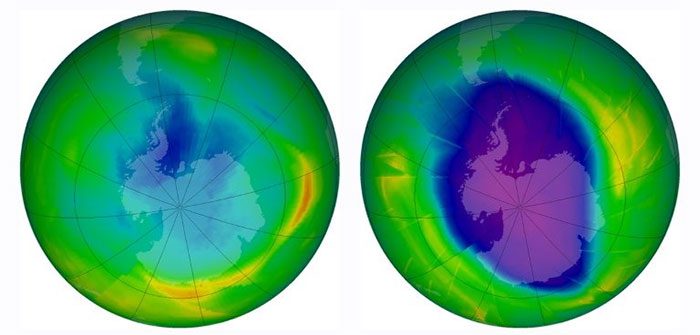The ozone layer is a type of “belt” surrounding the Earth made up of gas molecules. It protects all living organisms by absorbing two types of ultraviolet radiation.
In 1985, scientists discovered a significant loss of the ozone layer over Antarctica, with 40% of this layer depleted, resulting in a “hole.”
The biggest issue is chlorine from a man-made compound called Chlorofluorocarbons, or CFCs. On the ground, CFCs are harmless. However, once they rise into the stratosphere, the sun breaks them down into chlorine. This chlorine combines with ozone to create oxygen and chlorine monoxide. Subsequently, loose oxygen atoms push chlorine atoms out, freeing them to destroy even more ozone molecules. This triggers a chain reaction.

The phenomenon of the ozone hole still exists, but its severity is gradually decreasing.
One chlorine atom can destroy nearly 100,000 ozone molecules. CFCs can persist in the atmosphere for about 50 to 150 years. They were widely used in industry and could be utilized as refrigerants, foaming agents, solvents, etc. In the last century, the use of such compounds in industry was very prevalent.
To prevent further destruction of the ozone layer, in 1987, the United Nations invited over 20 countries to sign the Montreal Protocol on Substances that Deplete the Ozone Layer (ODS). Since the protocol came into effect on January 1, 1989, the consumption of ozone-depleting substances, including CFCs, has decreased significantly.
Today, more than 30 years after the Montreal Protocol was signed, the ozone hole has stopped increasing and is currently shrinking. It is predicted that by 2065, the ozone layer may fully recover. However, there is still much work to be done.
Following the ban on CFCs, many countries began using Hydrofluorocarbons or HFCs. HFCs do not deplete the ozone layer, but they are a potent greenhouse gas contributing to climate change. They are also the fastest-growing gases. Therefore, in 2016, the Montreal Protocol was amended to include HFCs, and they are currently being phased out as well.
In other words, the phenomenon of the ozone hole still exists, but its severity is gradually decreasing, and there is no need to “stress” as much as before, thanks to the collective efforts of the global community, and it can be restored.


















































